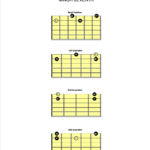In this video, Colin demonstrates how to map chord tone inversions up the fretboard in 2-string configurations through the chord changes of “Blues For Alice”.
As improvising guitarists, we need to be able to see possibilities on our fretboard in as many ways we can. The more options we explore, the more tools we will have to create with. This is especially the case when improvising over chord changes. In this episode, I’ll show you another useful chord tone mapping exercise that you can apply to your improvisation practice to help you know your guitar inside out.
I hope you’re feeling stronger at playing chord tones all over your fretboard with the exercise we covered in Part 1. If you haven’t watched that video yet, click back to that first, as this one will make much more sense after having practiced that concept.
Now that we’ve mapped chord tones across our three string groupings, let’s look at what happens when we place these chord tones across two strings. Using two notes per string, we can play all of the inversions of a seventh chord up the neck on a pair of strings. I’ll demonstrate this concept with Dm7. Dm7 has the pitches D F A C. Let’s play these chord tones on the top 2 strings of our guitar. I’ll start in root position on the 3rd fret of the B string. The b3 is on the 6th fret of that same string. Moving to the E string, the 5th of the chord is on the 5th fret and the b7 is on the 8th fret. To me, this is reminiscent of a minor pentatonic scale shape, except the notes on the high E are just moved up two frets. Pretty simple to play and to remember.
Moving to first inversion, we get a new shape: b3 5 b7 1. The second inversion shape: 5 b7 1 b3, is identical to our D minor pentatonic shape. And the 3rd inversion gives us another new shape as: b7 1 b3 5. This is like a reciprocal of the first inversion shape. Just like the 3-string shapes, some of these are more comfortable than others, but they’re all usable. Which one works best for our fingers simply depends on the situation.
I’ve posted a link below to a 30 page .pdf that you can download for $3 that has all of the 2-string chord shapes for the five basic seventh chords on all 5 string pairs plus a transcription with tablature of the exercises in this video.
2 String Chord Tone Shape Diagrams

Click below to purchase the 30 page PDF of 2-string Chord Tone Shape diagrams and transcribed exercises for this video. This will make memorizing these shapes accurately and quickly much easier for you.
So let’s apply this concept to a song with some chord changes in it. I’ll demonstrate a four-part exercise so we can explore how to connect these two-string chord tone shapes over the changes.
“Blues For Alice” by Charlie Parker has 16 unique chords in it. The first chord is Fmaj7. The lowest place on our fretboard to play those chord tones on our top two strings starts on our first fret of the B-string, C, which gives us second inversion. From there we will find E, then change strings for F and A. Let’s continue finding the lowest inversion for the remaining chords of the song so they are in the same vicinity on our fretboard.
Playing these chord tone shapes near each other shows us which pitches move and which overlap from chord to chord, which is helpful to know when creating smooth melodic lines over changes. Let’s do the same process for the next inversion. 3rd inversion Fmaj7 starts on E on the 5th fret of our B string. Do this again starting in Root Position. And finally in 1st inversion.
Once you’re familiar with the different ways to connect your two-string chord tone shapes, turn on a backing track or a metronome and practice playing them using the harmonic rhythm of the song. After that, be more creative and transition between the inversions up and down the strings. Then you can change the order of pitches and make it more melodic. I’ll demonstrate a chorus where I’ll improvise putting all of these elements together.
After you are strong doing this on the top two strings, repeat the process for your other pairs of strings. Have some fun with this exercise and be as creative as possible when doing it. And of course you can apply this concept to other songs you want to tackle the chord changes on. Thanks for watching, happy practicing, and I’ll see you next time on Inside Out Guitar!
Follow Colin Sapp on Instagram